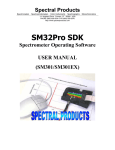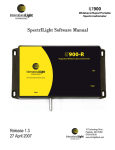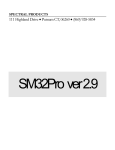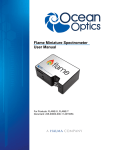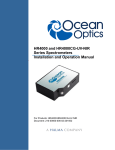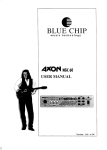Download Dear Sir/Madam, - Spectral Products
Transcript
Spectral Products Spectrometers · Spectrophotometers · Color Instruments · Spectrographs · Monochromators 111 Highland Drive · Putnam, CT · 06260 · USA PHONE (860) 928-5834· FAX (860) 928-2676 http://www.spectralproducts.com SM32Pro SDK Spectrometer Operating -Software Development KitUSER MANUAL For USB 2.0 Multi-channel User Only Spectral Products Spectrometers · Spectrophotometers · Color Instruments · Spectrographs · Monochromators 111 Highland Drive · Putnam, CT · 06260 · USA PHONE (860) 928-5834· FAX (860) 928-2676 http://www.spectralproducts.com Table of Contents Warranty and Liability .....................................................................................................3 Location of the SDK source code for USB 2.0 ................................................................4 System Requirements .....................................................................................................5 Getting Started ................................................................................................................6 Using the SP Libraries ....................................................................................................8 General Overview ...........................................................................................................9 SDK Functions ..............................................................................................................11 SDK Function Descriptions ..................................................................................... 12-23 spTestAllChannels .........................................................................................................................12 spSetupAllChannels ......................................................................................................................12 spSetupGivenChannel ...................................................................................................................13 spInitAllChannels ...........................................................................................................................13 spInitGivenChannel .......................................................................................................................14 spSetIntEx .....................................................................................................................................14 spSetDblIntEx ................................................................................................................................15 spSetTrgEx ....................................................................................................................................16 spSetTEC ......................................................................................................................................16 spSelectCF ....................................................................................................................................17 spReadDataEX ..............................................................................................................................17 spReadDataAdvEX ........................................................................................................................18 spCloseAllChannels ......................................................................................................................19 spCloseGivenChannel ...................................................................................................................20 spReadChannelID .........................................................................................................................20 spWriteChannelID .........................................................................................................................21 spGetAssignedChannelID .............................................................................................................21 spPolyFit ........................................................................................................................................22 spPolyCalc .....................................................................................................................................23 Spectral Products Spectrometers · Spectrophotometers · Color Instruments · Spectrographs · Monochromators 111 Highland Drive · Putnam, CT · 06260 · USA PHONE (860) 928-5834· FAX (860) 928-2676 http://www.spectralproducts.com Warranty And Liability This SM product is warranted against defects in material and workmanship for a period of one year from the date of shipment. During the warranty period, Spectral Products (SP) will, without charge, repair or replace, at its discretion, the defective product or component parts. For warranty service or repair, this product must be returned to a service facility designated by SP. For products returned under warranty, the Buyer shall prepay shipping charges (including shipping charges, duties, and taxes for products returned to SP from another country), and SP will pay for shipping charges to return the product to the Buyer. This warranty does not apply in the event of misuse or abuse of the product or as a result of unauthorized alterations, modifications or repairs, if the serial number is altered, defaced or removed, the improper or inadequate maintenance by the Buyer, Buyer-supplied software or interfacing, operation outside of the environmental specifications for the product, or improper site preparation or maintenance. No other warranty is expressed or implied. SP shall not be liable for any consequential damages, including without limitation, damages resulting from loss of use, as permitted by law. Spectral Products Spectrometers · Spectrophotometers · Color Instruments · Spectrographs · Monochromators 111 Highland Drive · Putnam, CT · 06260 · USA PHONE (860) 928-5834· FAX (860) 928-2676 http://www.spectralproducts.com The Location of the SDK source code for USB 2.0 If the software was installed with the installation CD, the SDK source codes are located in the directory that the software was installed. If the user didn’t change the installation directory and the Windows OS had been installed on “C:\” drive, the location of the SDK source codes is “C:\Program Files\Spectral Products\SM32Pro\SDK Examples\VC++_SDKs\SDK2XX-USB2.0” in general. The SDK examples can be downloaded from SP’s website (Click here). In case of other interface users, please refer to the manual located in each SDK example directory. The SDK directory name indicates the interface type. Spectral Products Spectrometers · Spectrophotometers · Color Instruments · Spectrographs · Monochromators 111 Highland Drive · Putnam, CT · 06260 · USA PHONE (860) 928-5834· FAX (860) 928-2676 http://www.spectralproducts.com System Requirements Requirements for the Software • • • • • • • Any IBM compatible computer A hard drive with at least 50 MB free space A CD-ROM A VGA or compatible display 32 MB RMA or higher A mouse or other pointing device Microsoft Windows® 98, 98SE, ME, NT, 2000, and XP Check System Package Contents Check that your SM system package contains all of the required components. Common system packages contain the fallowing: • • • Spectrometer USB 2.0 Cable Any accessories ordered Note: Package contents may vary from unit to unit and order to order. If you have any questions about the contents of your package, please contact the support team referred to in the back of this manual. Spectral Products Spectrometers · Spectrophotometers · Color Instruments · Spectrographs · Monochromators 111 Highland Drive · Putnam, CT · 06260 · USA PHONE (860) 928-5834· FAX (860) 928-2676 http://www.spectralproducts.com Getting Started Welcome to the Spectral Products’ SM32Pro Software Development Kit. This kit documents a library of functions for accessing the USB 2.0/1.1 Data Acquisition Board used by the CCD detector units. Two fundamental CCD imaging concepts are the Collection of Data and Generating Meaningful Values from that data. Collection of Data In our array detector spectrometers, the light is dispersed across 512 (Hamamatsu, InGaAs), 1024 (Hamamatsu, Back-thinned TE cooled CCD), 2048 (Sony CCD or Hamamatsu back thinned CCD) or 3648 (Toshiba CCD) pixel detector array. Data is collected by each pixel and converted to a relative value by the analog-to-digital (A/D) converter ranging from 0 to 65535 and representing the intensity of the light at each pixel. We are able to control the amount of time that the pixels collect light and thus read signals of varying strengths. Using this library of functions you will be able to adjust the signal capture time (Integration Time) and collect the converted signals from each pixel. The criteria to adjust the integration is to try different lengths of time with a reference signal representing the maximum possible signal level during the measurement until the peak value across the range of pixels is close to, but not at 65535. We recommend trying to get the peak at 65000 around. This way you can be sure that you are getting an optimized measurement condition with no saturation of CCD elements. Generating Meaningful Values The information you collect from the system is only the relative signal size at each detector pixel until it has been calibrated to absolute (certified reference) values. That is in the raw data, the pixel location represents spatial distribution of the CCD elements and the corresponding intensity is represented by a digital value. Since we can adjust the strength of the light source and the integration time of the CCD, this A/D value only provides a relative representation of the real world parameters. We address both of these problems. We connect pixels to wavelengths by use of known emission lines (e. g. SP‘s calibration light sources or narrow band filters) across the range of pixels together with a table relating pixels to wavelengths in nanometers. Curve fitting functions can then be applied to Spectral Products Spectrometers · Spectrophotometers · Color Instruments · Spectrographs · Monochromators 111 Highland Drive · Putnam, CT · 06260 · USA PHONE (860) 928-5834· FAX (860) 928-2676 http://www.spectralproducts.com generate a polynomial function for the conversion of all other pixels to wavelengths. We address the second problem in one of two ways. Both ways involve “normalization.” Normalization involves measurements of signal strength based on its ratio with respect to reference signal intensity. If we are only interested in the spectral distribution of the sample signal, then we can normalize a sample signal scan to one reference value by, for example, intensities of all the array elements divided by the peak intensity. If we want to measure percent transmission, the light can be measured first with only air in the light path as 100% reference and then the sample can be inserted into the light path and a sample scan followed. Consequently, the divisions of sample scan readings by the 100% reference yields the relative transmission values, or percent transmission when multiplied by 100%. For reflectance measurement similar practice can be applied and a high reflector can be used as a reference air in many cases. It is strongly recommended that a measurement be taken prior to any sample scan, in which no external light but only the detector noise will be sensed and subsequently subtracted from all the following measurements. This will subtract thermally generated “background” DC offset level and statistically establish a baseline of zero for all subsequent measurements. Spectral Products Spectrometers · Spectrophotometers · Color Instruments · Spectrographs · Monochromators 111 Highland Drive · Putnam, CT · 06260 · USA PHONE (860) 928-5834· FAX (860) 928-2676 http://www.spectralproducts.com Using the SP Libraries For Windows C/C++, you must include the correct “include” file and “lib” file for the functions you are calling: For Visual Basic, please include the correct “BAS” file. The function declarations listing in this file demonstrate the correct data types. To pass a “pointer” or array to a DLL from Visual basic, simply pass the first element of the array (IE SampleData[0]). Please refer to the samples or give us a call if you need any further technical assistance. Procedure for using the .dll with VC++ 1. The SPdbUSBm.dll and SPdbUSBm.lib need to be copied to the work or release folder. Those are located in the “[Software installed directory]\SDK Examples\VC++_SDKs\SDK2XX-USB2.0\DLL”. 2. Add SPdbUSBm.lib to the project/settings/link/object/library module. Spectral Products Spectrometers · Spectrophotometers · Color Instruments · Spectrographs · Monochromators 111 Highland Drive · Putnam, CT · 06260 · USA PHONE (860) 928-5834· FAX (860) 928-2676 http://www.spectralproducts.com General Overview Some basic fundamentals of utilizing the SP SDK functions First spTestAllChannels() has to be called to get the total number of channels that are currently connected to the computer. It returns the total number of channels connected. Then spSetupAllChannels() or spSetupGivenChannel() should be called to set up each USB port connection. The spInitAllChannels() or spInitGivenChannel() needs to be called to initialize the setup components and values. After consecutively calling the three functions above, you can call any function in the DLL. Integration time is the time period the CCD pixels are exposed to light before the resulting charges are read out. A longer integration time can allow you to detect a lower light level signal. The longer your integration time is the more background signal will accumulate. Using Curve Fitting to Calibrate SM32Pro Curve fitting is used in SM32Pro/SDK to correlate the physical locations of pixels on the CCD with the known wavelength of the radiation falling on them. This is done by identifying the pixel locations where the maximal of the known wavelength is at. These peak intensity wavelengths and pixels are used by spPolyCalc() and spPolyFit() to generate a correlating polynomial function which best represents all the data points. We have found that using a third order polynomial function produced the most desirable results for most cases. In cases where high dispersion elements are used, lower order polynomial functions may have to be utilized due to the limited known wavelengths available from the calibration lamps. Calibration Files Each unit’s calibration set is included in the SM32Pro software settings, “SM32Pro.ini”. This text file contains calibration data of the form “DataX=Wavelength;Pixel”. The file also contains the regression coefficients “A0 value”, “A1 value”, … , “B3 value” that satisfy the equations. l i = A0 + A1 P i + A2 P i 2 + A 3 P i 3 Pi= B0 + B1 l i + B 2 l i 2 + B 3 l i 3 . The A values are the coefficients for conversions from a pixel number to a wavelength in “nm” by use of the above first third order polynomial function. The B values allow the conversions from a desired wavelength in “nm” to a pixel number. Spectral Products Spectrometers · Spectrophotometers · Color Instruments · Spectrographs · Monochromators 111 Highland Drive · Putnam, CT · 06260 · USA PHONE (860) 928-5834· FAX (860) 928-2676 http://www.spectralproducts.com SDK Functions Data Acquisition spTestAllChannels - Used to check up the total number of channels connected. The USB connection order type needs to be set in this function. spSetupAllChannels spSetupGivenChannel - Used to set up and establish the USB connection in all channels or each channel. spInitAllChannels spInitGivenChannel - Used to initialize the components and values. The total pixel number of the array detector, the detector type (Sony CCD, Toshiba CCD, or Hamamatsu back thinned CCD/InGaAs) and the initial integration time are set in this function. spSetTrgEx - Used to set triggering type. The external triggering option can be set in this function. spSetIntEx - Used to set the CCD integration time. spSetTEC (SM303-Si/SM303-InGaAs Only) - Used to turn the TE cooling on/off. spSelectCF (SM303-InGaAs Only) - Used to set the capacity size (1pF/10pF). spReadDataEx spReadDataAdvEx - Used to collect spectral data from the CCD. spCloseAllChannels spCloseGivenChannel - Used to close the USB connection. This function should be called at the exiting of program. Spectral Products Spectrometers · Spectrophotometers · Color Instruments · Spectrographs · Monochromators 111 Highland Drive · Putnam, CT · 06260 · USA PHONE (860) 928-5834· FAX (860) 928-2676 http://www.spectralproducts.com Channel Configuration spReadChannelID - Used to read the channel ID assigned and saved in the EEPROM on the USB board. spWriteChannelID - Used to write a new channel ID on the EEPROM on the USB board. spGetAssignedChannelID - Used to get the information of all channel IDs assigned. Calibration spPolyFit - Used to generate a calibration function from pixels to wavelength. This function calculates the coefficients for a polynomial curve fitting function given an array of independent variables and a corresponding array of dependent variables. spPolyCalc - Used for determining the wavelength for a given pixel location. This function calculates a polynomial function given the independent variable and a coefficient array. Spectral Products Spectrometers · Spectrophotometers · Color Instruments · Spectrographs · Monochromators 111 Highland Drive · Putnam, CT · 06260 · USA PHONE (860) 928-5834· FAX (860) 928-2676 http://www.spectralproducts.com SDK Function Descriptions spTestAllChannels short spTestAllChannels ( short sOrderType = SP_ORDER_BY_CHANNELID // The order of USB connection: // SP_ORDER_BY_CHANNELID or // SP_ORDER_BY_USBPORTNUM ) This function is used to test and check the connection of USB boards. sOrderType is the type of the USB port connection order. If the user wants to define each channel by the order of the USB port connection, set the sOrderType as “SP_ORDER_BY_USBPORTNUM” which is “0”. If the user wants to define each channel by the assigned channel ID, set the value as “SP_ORDER_BY_CHANNELID” which is “1”. The default is “1” i.e. SP_ORDER_BY_CHANNELID. When the “SP_ORDER_BY_CHANNELID” was selected but the USB boards connected don’t have proper channel IDs assigned, this function will reassign the channel ID as the same as the USB port number of each USB board. RETURN If the function works properly, it will return the total number of channels connected. If not, it will return a negative number. spSetupAllChannels short spSetupAllChannels ( ) This function is used to set up and check the connections of all USB boards at once. RETURN If there is no error, it will return a positive value (SP_NO_ERROR). If not, a negative one. Spectral Products Spectrometers · Spectrophotometers · Color Instruments · Spectrographs · Monochromators 111 Highland Drive · Putnam, CT · 06260 · USA PHONE (860) 928-5834· FAX (860) 928-2676 http://www.spectralproducts.com spSetupGivenChannel short spSetupGivenChannel ( short sChannel = 0 // The channel ID or USB port number ) This function is used to set up and check the connection of the given USB board. sChannel could be the assigned channel ID or the USB port number according to the setting of the spTestAllChannels() function. RETURN If there is no error, it will return a positive value (SP_NO_ERROR). If not, a negative one. spInitAllChannels short spInitAllChannels ( short sCCDType = SP_CCD_SONY // the type of CCD installed in the // spectrometer ) This function is used to initialize all USB boards connected at once. sCCDType indicates what kind of detector is installed in the spectrometer. If the detector is Sony ILX511 (SM2xx series), then it should be “SP_CCD_SONY (0)”, if Toshiba TCD1304AP (SM4xx series), then “SP_CCD_TOSHIBA (1)”, if Hamamatsu Back-thinned TE cooled CCD S70311006 (SM303-Si), then “SP_CCD_PDA (2)”, if Hamamatsu InGaAs array G9212 (SM303-InGaAs), then “SP_CCD_G9212 (3)”, and if Hamamatsu Back thinned CCD S10420 (SM642), then “SP_CCD_S10420 (4)”. When all spectrometers have the same type of CCD, use this function to initialize. RETURN If there is no error, it will return a positive value (SP_NO_ERROR). If not, a negative one. Spectral Products Spectrometers · Spectrophotometers · Color Instruments · Spectrographs · Monochromators 111 Highland Drive · Putnam, CT · 06260 · USA PHONE (860) 928-5834· FAX (860) 928-2676 http://www.spectralproducts.com spInitGivenChannel short spInitAllChannels ( short sCCDType = SP_CCD_SONY, // the type of CCD installed in the // spectrometer short sChannel = 0 // The channel ID or USB port number ) This function is used to initialize the given USB board. sCCDType indicates what kind of detector is installed in the spectrometer. If the detector is Sony ILX511, then it should be “SP_CCD_SONY” which is 0, if Toshiba TCD1304AP, then “SP_CCD_TOSHIBA” which is 1, if Hamamatsu Back-thinned CCD, then “SP_CCD_PDA” which is 2, if Hamamatsu InGaAs array, then “SP_CCD_G9212” which is 3, and if Hamamatsu Back thinned CCD S10420, then “SP_CCD_S10420” which is 4. sChannel could be the assigned channel ID or the USB port number according to the setting of the spTestAllChannels() function. Use this function to initialize each USB board separately when each spectrometer has a different CCD. RETURN If there is no error, it will return a positive value (SP_NO_ERROR). If not, a negative one. spSetIntEx short spSetIntEx ( long const lIntTime, //new integration time short sChannel = 0 // The channel ID or USB port number ) Spectral Products Spectrometers · Spectrophotometers · Color Instruments · Spectrographs · Monochromators 111 Highland Drive · Putnam, CT · 06260 · USA PHONE (860) 928-5834· FAX (860) 928-2676 http://www.spectralproducts.com This function is used to set and change the integration time. lIntTime is amount of time in milliseconds for Sony CCD or Hamamatsu PDA detector or in 10 microseconds for Toshiba CCD to set as a new integration time. This number should range between 1 and 65535 for Sony CCD or Hamamatsu InGaAs detector, between 7 and 65535 for Hamamatsu backthinned CCD and between 1 and 6553500 for Toshiba CCD. In the case of Toshiba CCD, the minimum integration time is 10 microseconds and the value setting is based on 10 microseconds. For example, lIntTime of “100” is 1 millisecond. To avoid the misleading, it is recommended for Toshiba CCD spectrometer users to use the spSetDblIntEx() function for setting the integration time. sChannel could be the assigned channel ID or the USB port number according to the setting of the spTestAllChannels() function. RETURN If there is no error, it will return a positive value (SP_NO_ERROR). If not, a negative one. spSetDblIntEx short spSetDblIntEx ( double const dIntTime, short sChannel = 0 ) //new integration time // The channel ID or USB port number This function is used to set and change the integration time. dIntTime is amount of time in milliseconds to set as a new integration time. This number should range between 0.01 and 65535.0 for Toshiba CCD, between 1.0 and 65535.0 for Sony CCD or Hamamatsu InGaAs detector and between 7.0 and 65535.0 for Hamamatsu back-thinned CCD. In the case of Toshiba CCD, the value will be rounded off to two decimal places. In the case of other detectors, all numbers below decimal point will be off so it is recommended using the spSetIntEx() function rather than this one. sChannel could be the assigned channel ID or the USB port number according to the setting of the spTestAllChannels() function. RETURN Spectral Products Spectrometers · Spectrophotometers · Color Instruments · Spectrographs · Monochromators 111 Highland Drive · Putnam, CT · 06260 · USA PHONE (860) 928-5834· FAX (860) 928-2676 http://www.spectralproducts.com If there is no error, it will return a positive value (SP_NO_ERROR). If not, a negative one. spSetTrgEx short spSetTrgEx ( short const sTrgMode //Sets triggering mode short sChannel = 0 // The channel ID or USB port number ) This function is used to set and change the triggering mode. sTrgMode is used to set the trigger mode. If this value was set as “SP_TRIGGER_OFF” which is 10, the USB board runs freely. If an external triggering is needed, this value should be set as “SP_TRIGGER_EXTERNAL” which is 12. When the external trigger mode needs to be release to make the USB board run freely, set this value as “SP_TRIGGER_INTERNAL” which is 11. The default value is “SP_TRIGGER_OFF”. If the trigger mode doesn’t need to be set, then do not call this function. sChannel could be the assigned channel ID or the USB port number according to the setting of the spTestAllChannels() function. RETURN If there is no error, it will return a positive value (SP_NO_ERROR). If not, a negative one. spSetTEC (NOTE: SM303-Si/SM303-InGaAs Only) short spSetTEC ( long lTEC short sChannel = 0 ) //Sets TE Cooling On/Off // The channel ID or USB port number This function is used to turn the TE Cooler on or off. lTEC is used to set the TE Cooling On/Off. If this value was set as “1”, the USB board turns on the TE Cooling. If it is “0”, the TE Cooling mode will turn off. Spectral Products Spectrometers · Spectrophotometers · Color Instruments · Spectrographs · Monochromators 111 Highland Drive · Putnam, CT · 06260 · USA PHONE (860) 928-5834· FAX (860) 928-2676 http://www.spectralproducts.com sChannel could be the assigned channel ID or the USB port number according to the setting of the spTestAllChannels() function. RETURN If there is no error, it will return a positive value (SP_NO_ERROR). If not, a negative one. spSelectCF (NOTE: SM303-InGaAs Only) short spSelectCF ( long lCF short sChannel = 0 ) //Sets Capacity value as 1pF or 10pF // The channel ID or USB port number This function is used to select the capacity value for InGaAs array detector. lCF is used to set the capacity value of the detector. If this value was set as “1”, the capacity value will be 10pF. If it is “0”, the capacity value will be 1pF. 1pF capacity will give higher sensitivity but less stable signal and 10pF vice versa. sChannel could be the assigned channel ID or the USB port number according to the setting of the spTestAllChannels() function. RETURN If there is no error, it will return a positive value (SP_NO_ERROR). If not, a negative one. spReadDataEx: short spReadDataEx ( long * pArray; // The array in which spectral data is stored short sChannel = 0 // The channel ID or USB port number ) This function is used to read the CCD signal data through USB board. Spectral Products Spectrometers · Spectrophotometers · Color Instruments · Spectrographs · Monochromators 111 Highland Drive · Putnam, CT · 06260 · USA PHONE (860) 928-5834· FAX (860) 928-2676 http://www.spectralproducts.com pArray points to a read memory address. Its memory size should be larger than (or at least the same as) the detector pixel number defined at spInitAllChannels or spInitGivenChannel. The total CCD pixel number to be read is one of “SP_CCD_PIXEL_PDA” which is 1056, “SP_CCD_PIXEL_G9212” which is 512, “SP_CCD_PIXEL_SONY” which is 2080, “SP_CCD_PIXEL_S10420” which is 2080, or “SP_CCD_PIXEL_TOSHIBA” which is 3680. Some detector contains the dummy pixels or optical blank pixels. The real data pixel number is “SP_CCD_PIXEL_PDA_REAL” which is 1024, “SP_CCD_PIXEL_G9212_REAL” which is 512, “SP_CCD_PIXEL_SONY_REAL” which is 2048, “SP_CCD_PIXEL_S10420_REAL” which is 2048, or “SP_CCD_PIXEL_TOSHIBA_REAL” which is 3648. In case of Sony and Toshiba CCDs, the first 32 pixels are optical blank and in case of Hamamatsu backthinned CCDs, the first 10 pixels are optical blank. This function returns just raw data. Some detectors may give reversed data. The SM303-InGaAs give left-right mirrored data so those have to be re-mirrored. Also due to the intrinsic property of the InGaAs array detector’s response, all output signals are revered based on the A/D resolution so it has to be flipped over like data_real = 65535-data_read, where 65535 represents “16bit” A/D resolution and the “data_read” is the raw data. sChannel could be the assigned channel ID or the USB port number according to the setting of the spTestAllChannels() function. RETURN If there is no error, it will return a positive value (SP_NO_ERROR). If not, a negative one. spReadDataAdvEx: short spReadDataAdvEx ( long * pArray; short sTimeAve, short sBadPxlNum, short *spBad, short sChannel = 0 ) // The array in which spectral data is stored // Time averaging // Total number of bad pixel // Bad pixel location information // The channel ID or USB port number This function is used to read the detector signal data through USB board in advanced mode. Spectral Products Spectrometers · Spectrophotometers · Color Instruments · Spectrographs · Monochromators 111 Highland Drive · Putnam, CT · 06260 · USA PHONE (860) 928-5834· FAX (860) 928-2676 http://www.spectralproducts.com pArray points to a read memory address. Its memory size should be larger than (or at least the same as) the detector pixel number defined at spInitAllChannels or spInitGivenChannel. The total CCD pixel number to be read is one of “SP_CCD_PIXEL_PDA” which is 1056, “SP_CCD_PIXEL_G9212” which is 512, “SP_CCD_PIXEL_SONY” which is 2080, “SP_CCD_PIXEL_S10420” which is 2080, or “SP_CCD_PIXEL_TOSHIBA” which is 3680. Some detector contains the dummy pixels or optical blank pixels. The real data pixel number is “SP_CCD_PIXEL_PDA_REAL” which is 1024, “SP_CCD_PIXEL_G9212_REAL” which is 512, “SP_CCD_PIXEL_SONY_REAL” which is 2048, “SP_CCD_PIXEL_S10420_REAL” which is 2048, or “SP_CCD_PIXEL_TOSHIBA_REAL” which is 3648. In case of Sony and Toshiba CCDs, the first 32 pixels are optical blank and in case of Hamamatsu backthinned CCDs, the first 10 pixels are optical blank. In this function, all data conversion will be done in this function so they can be used as they are without any additional treatment. sTimeAve is for setting the total number for time averaging to get more stable and less noisy data. The data will be gathered for a given number and return as average. Its default is “1”. sBadPxlNum is used to set the total number of bad pixels. Due to the limitation in the current state-of-art for manufacturing array InGaAs and/or back thinned CCD, a few (<5) pixels could be bad ones. Even regular CCDs may generate some bad pixels when used for long time. Its default is “0”. spBad points to a bad pixel information. Each value indicates the location of the memory address, which uses zero-based numbering. Also each detector has its own optical blank pixels before active ones so the total optical blank pixel number has to be added. For example, if there is one bad pixel in the backthinned CCD detector and its location is the 243rd pixel in the active array, the value has to be “243 – 1 + 10” where “-1” is for converting 1-based numbering to 0-based one and “+10” is for compensating the optical blank pixels of the back thinned CCD, which is “10”. Its default is “NULL”. sChannel could be the assigned channel ID or the USB port number according to the setting of the spTestAllChannels() function. RETURN If there is no error, it will return a positive value (SP_NO_ERROR). If not, a negative one. spCloseAllChannels Spectral Products Spectrometers · Spectrophotometers · Color Instruments · Spectrographs · Monochromators 111 Highland Drive · Putnam, CT · 06260 · USA PHONE (860) 928-5834· FAX (860) 928-2676 http://www.spectralproducts.com short spCloseAllChannels ( ) This function is called to close all USB board connections. It should be called when exiting the application. RETURN If there is no error, it will return a positive value (SP_NO_ERROR). If not, a negative one. spCloseGivenChannel short spCloseGivenChannel ( short sChannel = 0 // The channel ID or USB port number ) This function is called to close the given USB board connection. sChannel could be the assigned channel ID or the USB port number according to the setting of the spTestAllChannels() function. RETURN If there is no error, it will return a positive value (SP_NO_ERROR). If not, a negative one. spReadChannelID short spReadChannelID ( short *spNum, short sChannel = 0 ) // The pointer that the Channel ID will be saved in // The channel ID or USB port number This function is called to read the channel ID of the given USB board. spNum is the pointer that the assigned channel ID of the USB board will be saved in. sChannel could be the assigned channel ID or the USB port number according to the setting of the spTestAllChannels() function. Spectral Products Spectrometers · Spectrophotometers · Color Instruments · Spectrographs · Monochromators 111 Highland Drive · Putnam, CT · 06260 · USA PHONE (860) 928-5834· FAX (860) 928-2676 http://www.spectralproducts.com RETURN If there is no error, it will return a positive value (SP_NO_ERROR). If not, a negative one. spWriteChannelID short spWriteChannelID ( short sNum, short sChannel = 0 ) // The Channel ID to save // The channel ID or USB port number This function is called to write the channel ID on the given USB board. sNum is the new channel ID to be saved on the USB board. sChannel could be the assigned channel ID or the USB port number according to the setting of the spTestAllChannels() function. RETURN If there is no error, it will return a positive value (SP_NO_ERROR). If not, a negative one. spGetAssignedChannelID void spGetAssignedChannelID ( short *spChannelID, ) // The pointer of the Channel ID assigned This function is called to get the assigned channel ID information. It is only available when the “SP_ORDER_BY_CHANNELID” was set on the spTestAllChannels() function. spChannelID is the pointer of the assigned channel ID information. The memory of this pointer has to be allocated before using this function. The total memory size must be the same as the total USB connection number which is returned by the spTestAllChannels() function. RETURN Spectral Products Spectrometers · Spectrophotometers · Color Instruments · Spectrographs · Monochromators 111 Highland Drive · Putnam, CT · 06260 · USA PHONE (860) 928-5834· FAX (860) 928-2676 http://www.spectralproducts.com None. spPolyFit short spPolyFit ( double *x, // Array of independent variables double *y, // Array of dependent variables short numPts, // Number of points in independent and dependent arrays double *coefs, // Pointer to array to hold calculated coefficients [index: 0 - order] short order // Order of polynomial ) This curve fitting function is used to find a polynomial function to calculate the wavelength of a given pixel. This function is used for calibration purposes. Either a calibration light source or a series of narrow band filters are scanned and the pixel locations of all known peaks are identified along with the known wavelength at that peak. These peak locations and wavelengths are stored in the arrays x and y, respectively. The arrays indices should range from 0 to [Number_of_Points - 1]. They are passed to the function along with a requested order for the polynomial fitting function and an array large enough to hold the coefficients (). This array is then used with spPolyCalc to calculate wavelength from pixels. x is an array containing the independent variables. It should range from 0 to (numPts-1). y is an array containing the dependent variables. It should range from 0 to (numPts-1). numPts is the number of points in the variable arrays. coefs is a pointer to the array that will contain the polynomial coefficients. It should range from 0 to (order-1). order is the desired order of the polynomial. We have determined third order to be the optimum for wavelength calibration for most cases. RETURN This function will return 1 if the function is successful. Otherwise it will return negative. Spectral Products Spectrometers · Spectrophotometers · Color Instruments · Spectrographs · Monochromators 111 Highland Drive · Putnam, CT · 06260 · USA PHONE (860) 928-5834· FAX (860) 928-2676 http://www.spectralproducts.com spPolyCalc void spPolyCalc ( double *coefs, short order, double x, double *y ) This function calculates for the following formula: y = a0 + a1*x1 + a2*x2 + ... + aN*xN, where * specified multiplication. coefs is a pointer to an array containing the polynomial coefficients. These can be calculated using spPolyFit. order specified the order of the polynomial equation and must be less than or equal to the number of elements in coefs. x is the independent variable, in this case, the pixel number. y is the value to be calculated. RETURN None























